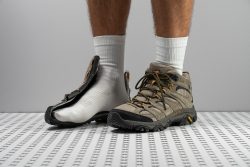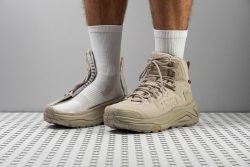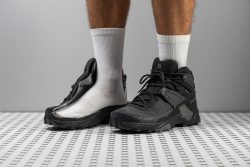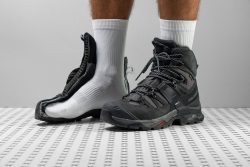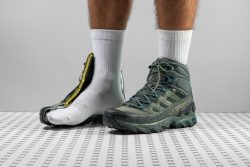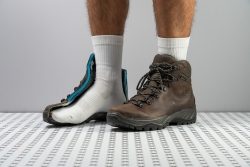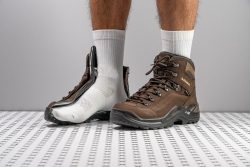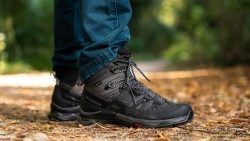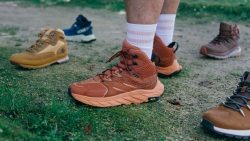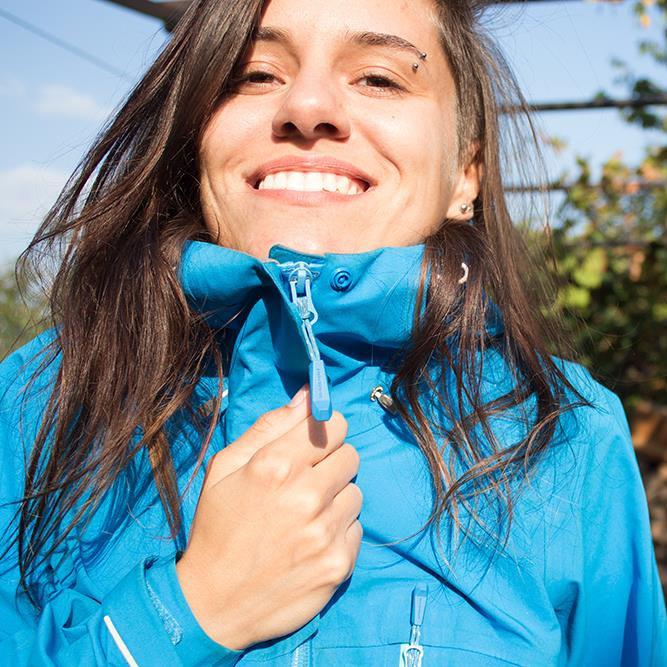7 Best Flat Feet Hiking Boots in 2025
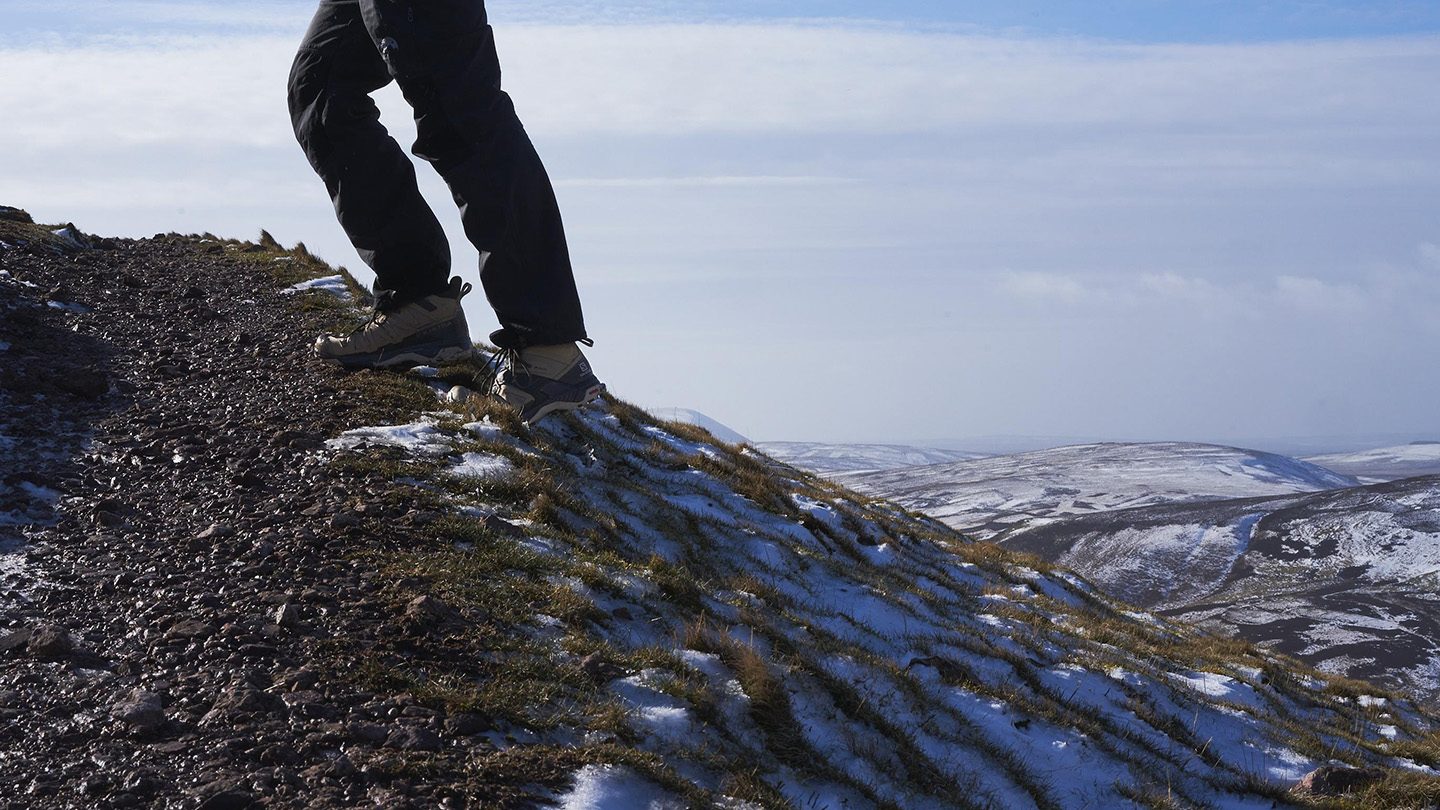
We buy shoes ourselves. We earn commissions when you buy through us, at no extra cost. Why trust us
Flat feet can cause discomfort or even pain on longer hikes, especially if the boots are not supportive and stable enough. Worry not because here, you'll find our best of the best picks in different categories.
We've tested these boots on the hikes and in our lab, which is why we also elaborate on why each pair got the spotlight! And, if you're curious about how we filter out the hiking boots for flat feet and which criteria they have to meet, read our guide section. We cover everything, from stiff heel counters and firmer platforms to the grip and insole thickness.
How we test flat feet hiking boots
When it comes to footwear testing, we focus on objectivity and transparency. Our process entails:
- Buying all the hiking boots with our own money. We have no brand ambassadors on the team and we're at all times free to publish whatever we discover or experience.
- We go hiking and test the boots on the trails. Our hikes are done in "good" and "bad" weather if that exists, so the boots are subjected to both wet and dry conditions and surfaces.
- We test the hiking boots in the lab, where we use different instruments (durometer, callipers, smoke machine, gels, tyre tread gauge, Dremel) to quantitatively describe each boot with 20+ data points.
- We publish everything we discover on our website, where you can compare the hiking boots by features you're particularly interested in, or you can look at the averages to better understand how the current boot performed on our lab tests.
- We cherry-pick the best hiking boots that we highlight in the buying guide and we do it based on our a) personal experience with the boots and b) lab results.
Best hiking boots for flat feet overall
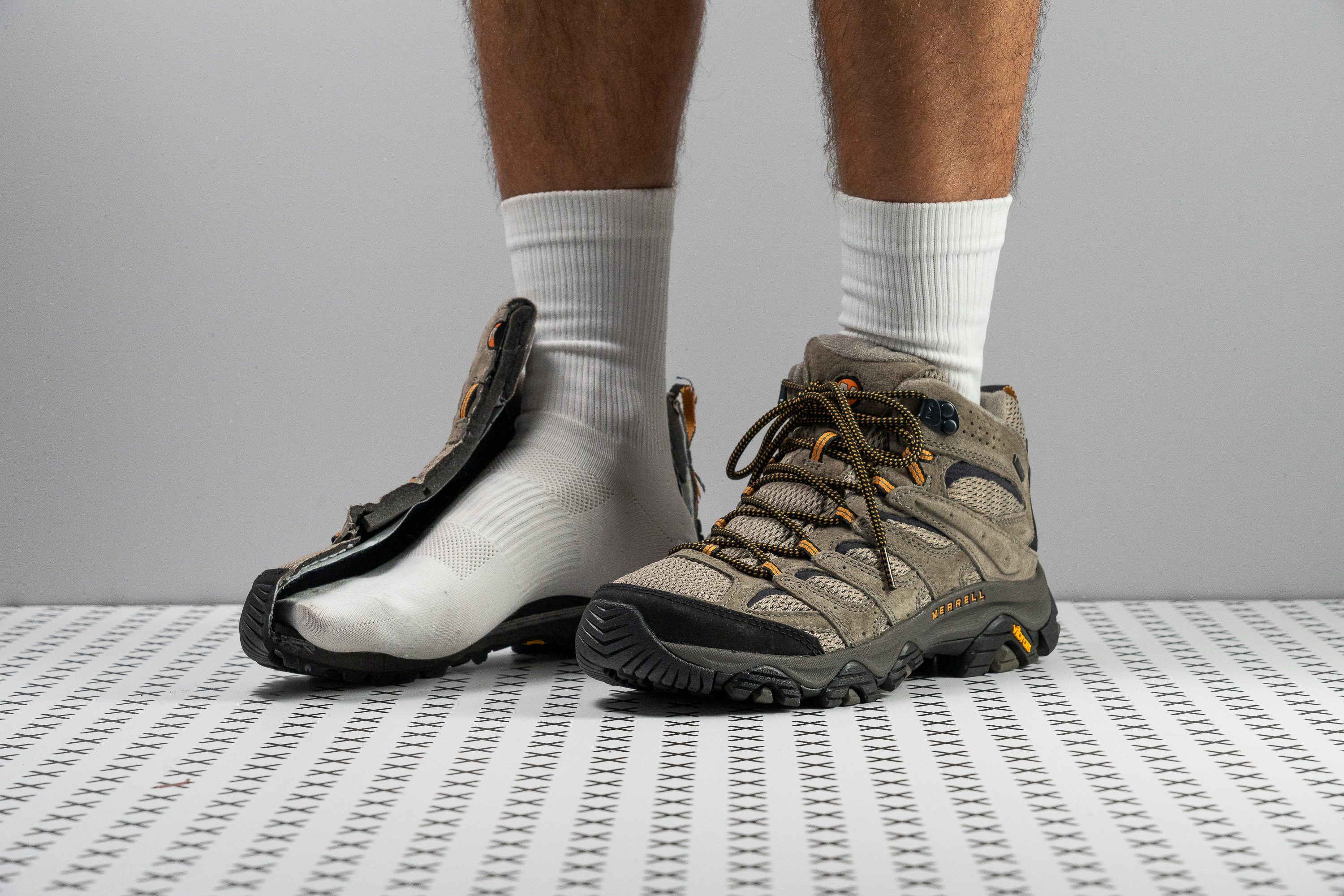






















































What makes it the best?
The Merrell Moab 3 Mid GTX carried us through our hikes with confidence by providing unwavering support without compromising comfort, making it our best flat-feet hiking boot. Our lab tests validate it has stiff elements in the right areas, a grippy base for enhanced control, and a balanced cushion underneath.
This boot has a stiff nylon shank in the midfoot adding structure to the shoe. It bolstered our ankles effectively, putting away any chances of toppling over. The shoe’s torsional rigidity and heel counter had the right amount of stiffness (4/5) to support us without being too intrusive.
The platform also feels nice and stable at 32.8 HA. This kind of firmness helps in preventing foot pain. Meanwhile, we found a softer 24.6 HA foam under the heel to soften landings and boost comfort. For all the things Moab 3 Mid GTX offers, we were surprised to find it weighs 7.5% lighter than the average boot.
Our encounters with water kept us at ease because the waterproof upper and sticky Vibram outsole kept us safe. No matter how slippery the trail was, we remained in control thanks to the deep 5.0 mm lugs. However, they are not sharp enough to handle soft terrain. Those who often encounter mud should find more aggressive boots.
Pros
- Best-in-class waterproofing
- Great stability for moderate hikes
- Supportive for all-day wear
- Comfortable step-in feel
- Excellent grip on hard terrain
- Secure lockdown
- Sturdy construction
- Sturdy construction
Cons
- Moderate impact protection
- Mesh panels are easy to tear
- Not for mud or soft terrain
- Moderate impact protection
Hiking boots for flat feet with the best shock absorption
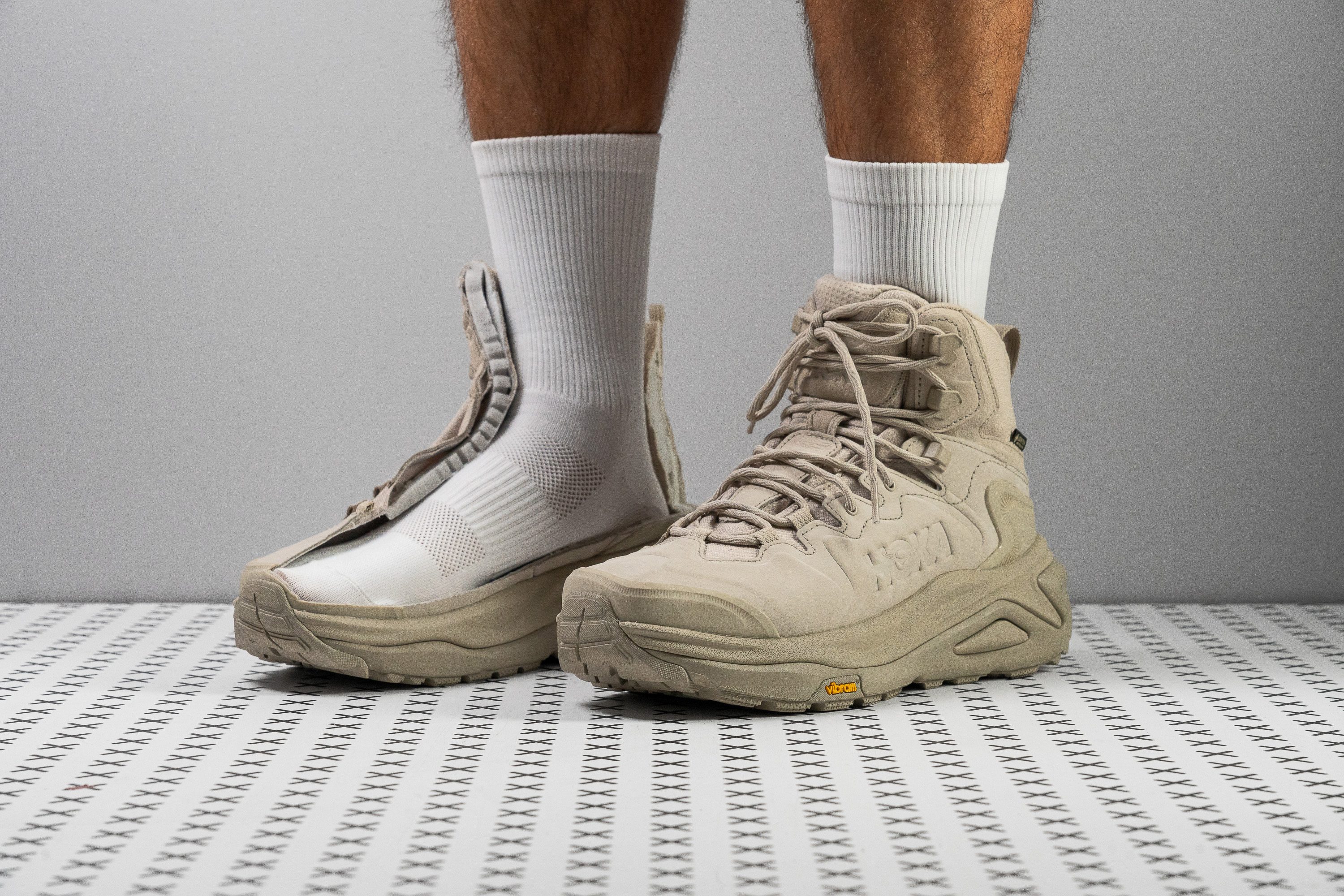
















































What makes it the best?
During our treks in the Hoka Kaha 3 GTX, we felt its remarkable ability to soothe tired, aching feet. It worked its magic by offering the best shock absorption among flat-foot hiking boots we assessed in the lab, without foregoing the support needed to stabilise our steps.
Eager to put a number on the comfort we experienced, we took the boot straight to our shock absorption test. We recorded a strong 120 SA rating, which means it’s able to reduce impact by 29.0%, which feels less taxing on our muscles after a long day of hiking.
Besides its plush cushioning, Kaha 3 GTX offers superior protection through its thick 41.9/30.4 mm stack. For context, the average hiking boot is only 36.3/23.0 mm tall. The platform also features a steep 11.5 mm drop, which puts less strain on our foot muscles and ankles.
What also lessens the chance of pain and injuries is its highly sure-footed ride. With its broad 115.0/96.4 mm base and high 5/5 torsional rigidity, it assists us in maintaining our balance. Because of the boot’s stability, it reduces the effort our muscles need to exert to control our footing.
However, this heavy-duty boot will be overkill for short hikes. We recommend going for a lighter, more agile option on easy days.
Pros
- One of the best cushioned boots ever
- Extremely comfortable for long miles
- Highly stable and supportive
- Excellent traction on smooth surfaces
- Grips mixed and hilly terrain well
- Contains sustainable materials
- More streamlined than the Kaha 2
Cons
- Lugs got much shallower
- Heavier than average
Hiking boots for flat feet with the best ground feel
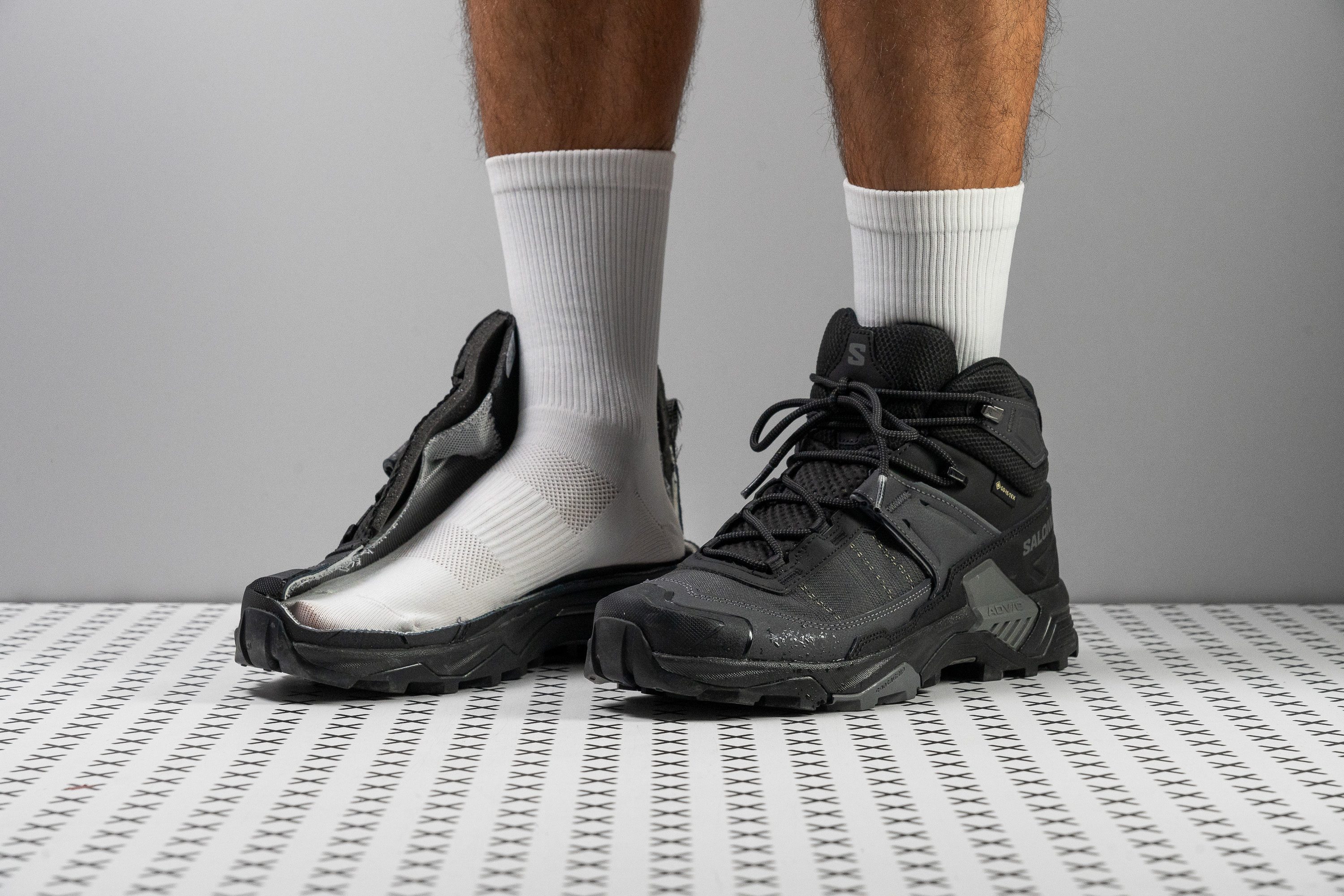











































What makes it the best?
The Salomon X Ultra 5 Mid GTX is an awesome companion for dealing with mixed terrain because of its weightlessness, adaptability, and direct surface feedback. In the lab, we discovered its low profile and minimal cushioning, making it our flat-feet hiking boot with the best ground feel.
The boot feels exceptionally stable, naturally enhanced by its low 32.5/19.8 mm stack. Moreover, we recorded a low shock absorption score of 88 SA in the heel, which means having a stronger connection to the trails and allowing us to adapt easily.
The Ultra 5 Mid GTX adds manoeuvrability through its light and loose build. Weighing 15.4 oz (437g) on our scales, it’s 17.7% below the average hiking boot. Moreover, its forefoot emerged 34.3% more bendable than average, saving us lots of energy since we have less resistance to fight to move.
The Contagrip outsole effortlessly handled various surfaces, from loose ground to wet rocks. It scored 0.48 in our traction test, proving its capability of standing its ground firmly. While this boot’s traction excels on most surfaces, we can’t say the same for super muddy trails. We recommend deeper and better-spaced lugs for this type of terrain.
Pros
- Stable and grounded platform
- Flexible forefoot adds manoeuvrability
- Great grip on wet terrain and rocks
- Surefooted on mixed and hilly trails
- Much lighter than average
- Excellent Gore-Tex waterproofing
- Tough and durable upper
Cons
- Minimal cushioning and shock absorption
- Not for deep mud
Best backpacking boots for flat feet
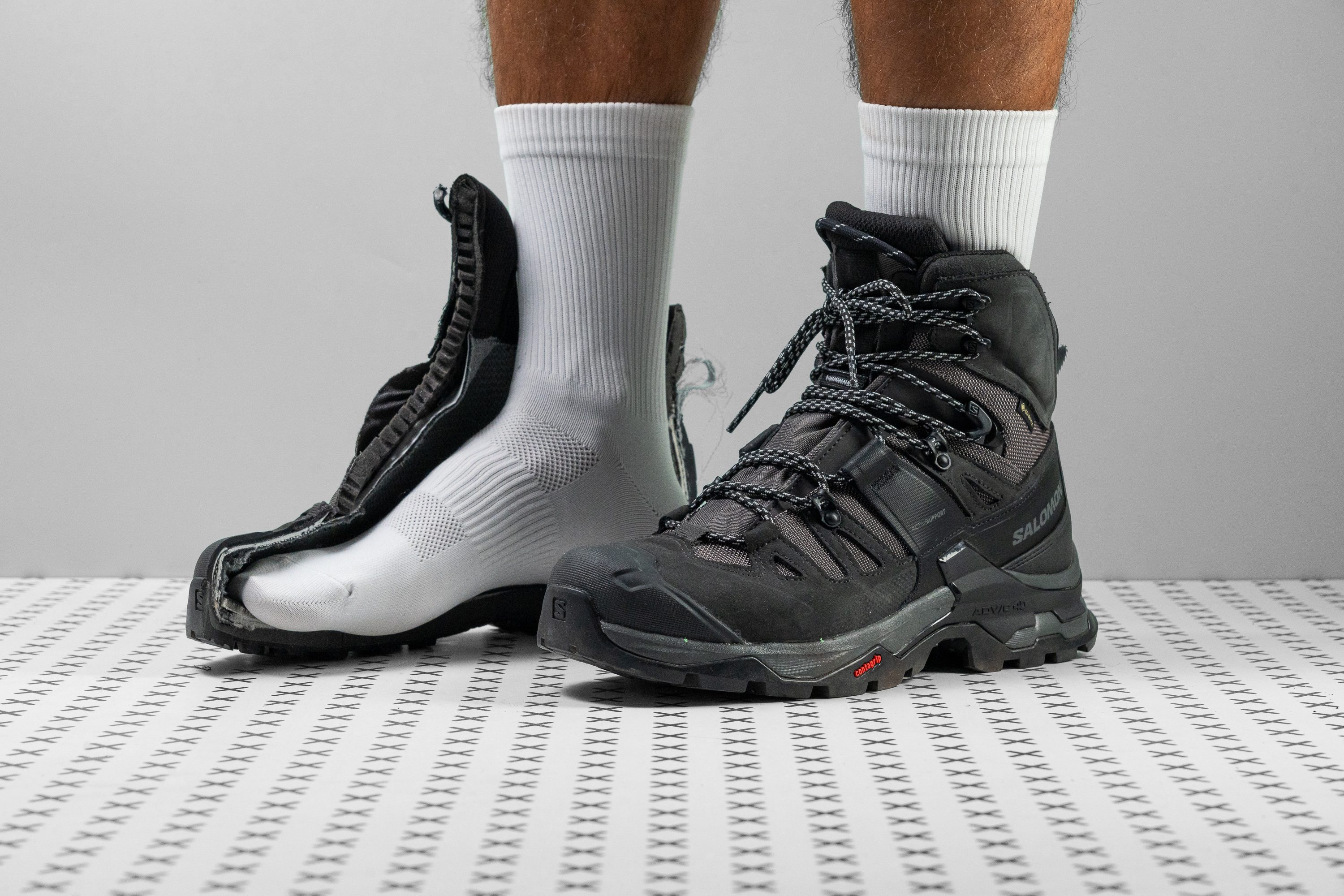















































What makes it the best?
The Salomon Quest 4 GTX offers steady and unyielding support during our trips to the mountain. Our lab tests confirm it has stiff stabilising components, reliable grip, and a balanced cushion in an ergonomic position for carrying heavy loads, making it our ultimate backpacking hiking boot for flat feet.
At the core of Quest 4 GTX, we discovered the innovative ADV-C 4D Chassis after slicing the midsole, which is a rigid component that wraps around the heel and lateral sides to keep us centred. Ankle twists were out of the equation even as we approached difficult terrain, further evidenced by its 5/5 torsional rigidity and heel counter stiffness scores in our manual assessment.
Underfoot, the Contagrip rubber displayed reliable grip that further boosted our confidence. We measured the lugs at 4.7 mm deep and they were effective on various surfaces.
The cushion felt nice and well-balanced to our arches, to which our durometer agreed with a near-average 27.0 HA rating. We had a great mix of impact protection and ground feel with the 38.0/20.0 mm stack, with the 18.0 mm drop relieving our lower legs from the strain of carrying heavy backpacks.
However, it has a heavy build of 23.4 oz (663g). We recommend using this boot for more serious backpacking. Otherwise, it will be another load on the feet during moderate hikes.
Pros
- Exceptional durability
- Top-notch waterproofing
- Excellent underfoot protection
- Highly secure ankle support
- Fantastic stability
- Comfortable in-boot feel
- Effective grip on various terrain
- Fits as expected
Cons
- A bit heavy
- Gets very stiff in cold
Best lightweight hiking boots for flat feet
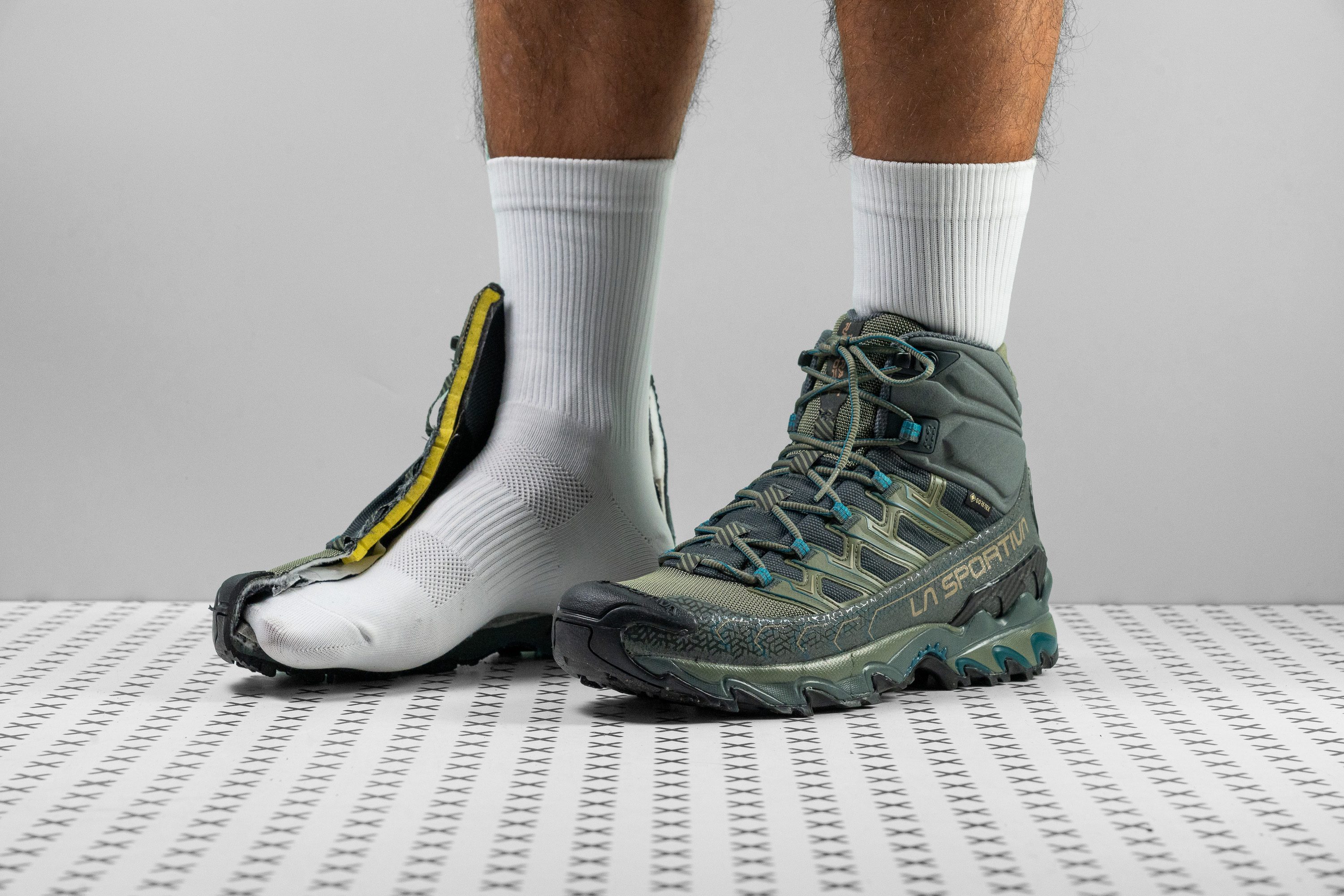















































What makes it the best?
Seamlessly blending agility and steadfast support into one boot, the La Sportiva Ultra Raptor II Mid GTX was a joy to wear on the trails. Our lab assessments validate its one-of-a-kind comfort and stability in an airy package, making it our ultimate lightweight flat-foot hiking boot.
At only 14.6 oz (415g), this boot manages to shed off 22.4% of the average boot’s weight while delivering solid support. It felt effortless to pick up the pace and it took very long before fatigue crept in.
Its effortless feel is further enhanced by the shoe’s longitudinal flexibility. It turned out to be 15.4% more bendable than average in our 30-degree flex test. However, it’s still rigid in the right areas. We rated its torsional rigidity a perfect 5/5 and its heel counter a stiff 4/5, which both prevent excessive movements and stabilise the ride. The support we experienced was undeniable.
We could easily adapt to a change in terrain and elevation thanks to the 4.3 mm grippy lugs. Its tread pattern consists of narrow, toothy, and broad shapes, allowing us to tackle the trails safely.
Unfortunately, it has a tight fit that may not be accommodating and stable for all. Those with broad feet should look for a wider boot.
Pros
- Unbelievably lightweight
- Excellent waterproofing
- Doesn't let debris and falling rain/snow inside
- Exceptionally robust and durable
- Phenomenal grip on technical terrain
- Not so stiff and firm in low temperature
- Sufficient impact protection
- Highly supportive collar
- Ample flexibility
Cons
- Narrow platform
- Not for wide feet
Best leather hiking boots for flat feet
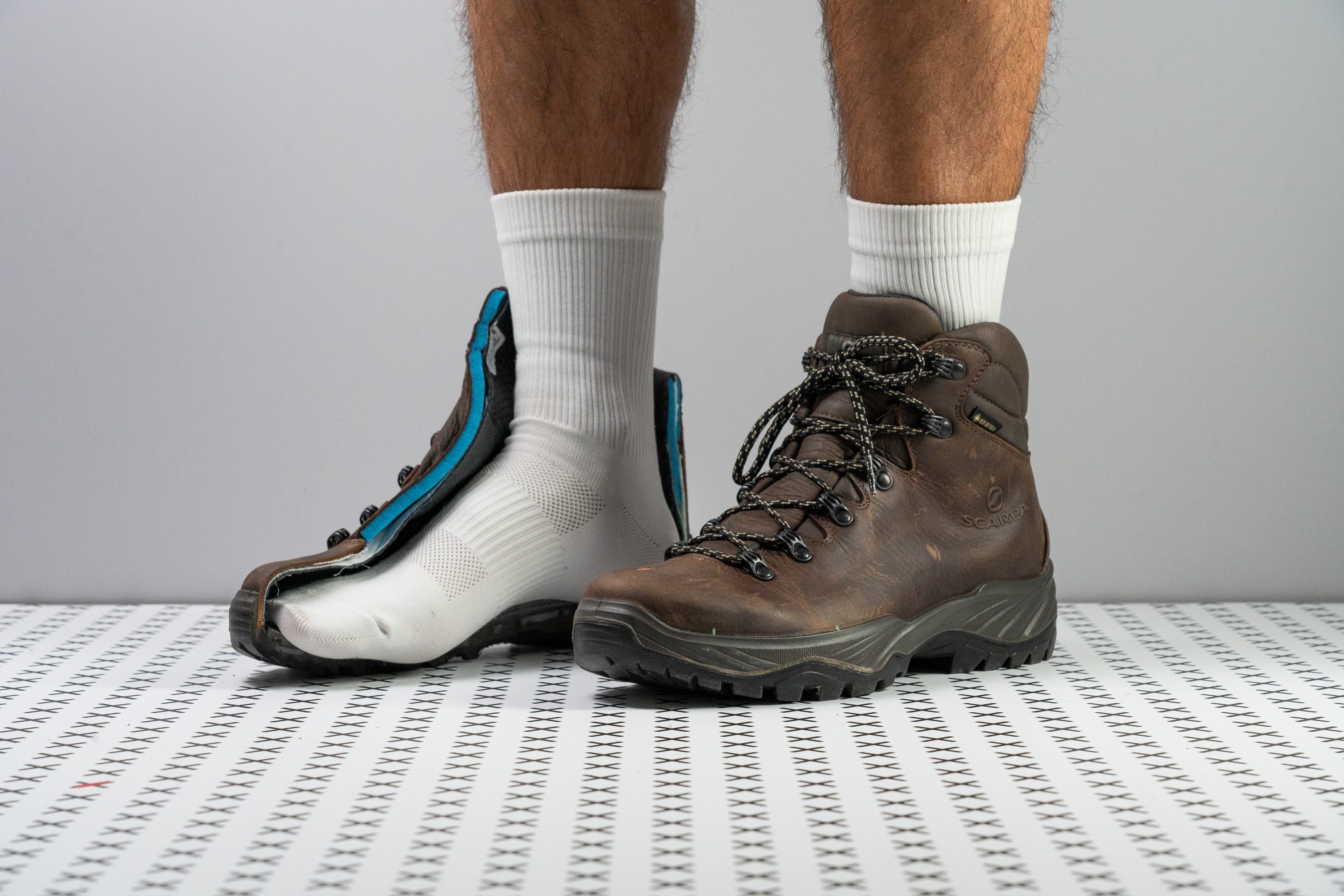







































What makes it the best?
From its airtight upper to its rock-solid support, and braking power, the Scarpa Terra GTX took care of our feet during our trail adventures. Backed up by the lab, we confirmed its stability through its low and firm stack and its high-quality leather that’s both waterproof and durable. It ticks the boxes and claims its position as our best leather flat-feet hiking boot.
The upper looked solid under our microscope and we confirmed its non-permeable nature when smoke remained inside the shoe in our breathability test, scoring 1/5. This means it also blocks off water. It also proved to be highly protective when it looked almost untouched after our Dremel test (5/5 durability).
The leather upper, together with the stiff TPU shank in the midsole, adds stiffness to the boot and holds our ankles firmly. The ride is further stabilised by the boot’s low profile and firm cushion. It measures a below-average 32.1/17.0 mm and emerged 6.1% stiffer than average, carrying our arches well.
Beneath the midsole, we unveiled the world-class Vibram outsole. It displays exceptional traction even on slippery surfaces, with its thick 4.0 mm lugs adding to our control over various terrains.
Unfortunately, its heavy 20.3 oz (575g) can lead to fatigue during long-haul efforts. Those who prioritise a light and agile ride should search for another option.
Pros
- Glue-like underfoot, even on wet surfaces
- Insanely comfortable
- Reliably stable and supportive ride
- Resilient and high-quality build
- Durable Vibram outsole
- Watertight and warm
- Quick break-in time
- Performs consistently in the cold
- Strong ankle support
Cons
- Quite heavy
- Cushioning could be better
- Scuff magnet
Hiking boots for flat feet with the best support
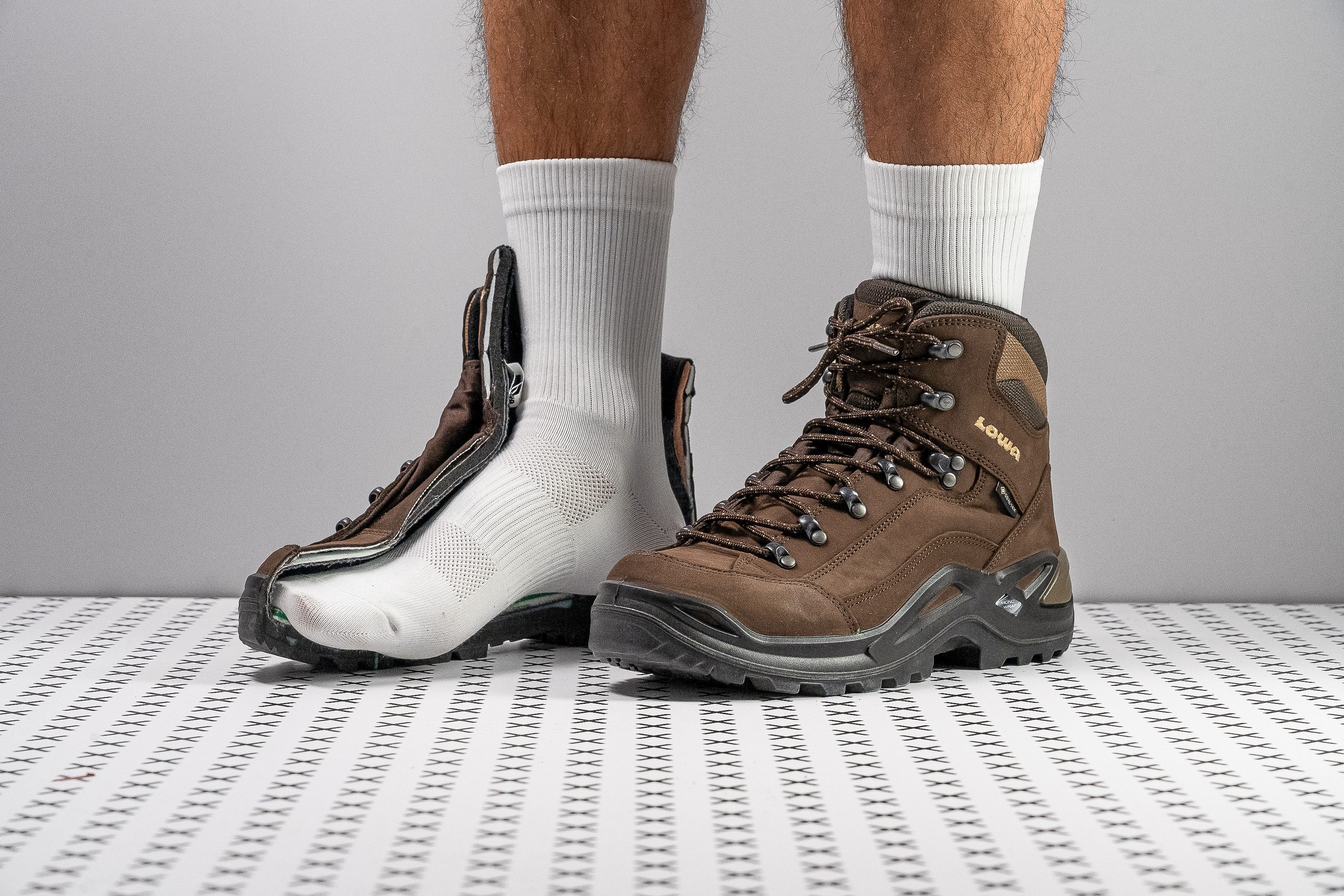



















































What makes it the best?
Robust from top to bottom, the Lowa Renegade GTX Mid is a tough soldier that armors our feet against ankle twists, foot pain, and external debris. Our lab tests back up our observation of the shoe’s highly stiff construction during our trips to the mountain, making it our flat-feet hiking boot with the best support.
It feels impossible to lose balance in this sturdy boot. Our sliced midsole reveals the MonoWrap frame in the midfoot, embracing our foot in place. This element increases the boot’s torsional rigidity and contains excessive movements. We tried to twist it with our own hands and it resisted fervently, earning the highest 5/5 torsional rigidity rating.
The boot has a hefty 21.1 oz (597g) build that keeps us centred and grounded. The cushion feels balanced, with a 25.6 HA rating, providing comfort to our arches without the foam compressing easily. Underfoot, the deep 5.1 mm lugs provided us with the traction we needed to tackle wet and dry surfaces safely.
The upper includes solid nubuck leather, which is highly resistant to abrasion, evidenced by its 5/5 toebox durability score based on our Dremel test. We had no worries about encountering water or protruding roots.
We warn caution that the shoe feels extremely stiff even to foot-bending, which may not be everyone’s cup of tea. Those who prefer an effortless feel should find a more flexible boot.
Pros
- Extremely supportive and stable ride
- Lightweight build
- Strong ankle support
- Excellent grip in dry and wet conditions
- Great backpacking companion
- Old-school nubuck leather upper
- Keeps our feet warm and dry
- Consistent performance in the cold
- Feels good out of the box
- Feels good out of the box
Cons
- Pricey
- Lots of seams in upper construction
- Finnicky lacing
- Too warm for summer hikes
This guide is written for hikers who have flat feet. If you’re not sure about your arches and how flat they are, we recommend reading our guide on arch support and visiting a specialist.
If you’re experiencing pain or discomfort, we also recommend visiting a podiatrist or a PT. This guide has an educational purpose and is in no way here to offer medical diagnosis.
Why do flat-footed hikers need different boots?
Flat feet are also known as low or fallen arches. When the arches are low or fallen, it means they are not strong enough to have full control over foot mobility. This weakness is something to be worked on, which is why we recommend seeing a specialist who would create an exercise plan for your specific needs. Stronger foot muscles and arches usually reduce the pain that is associated with flat feet.
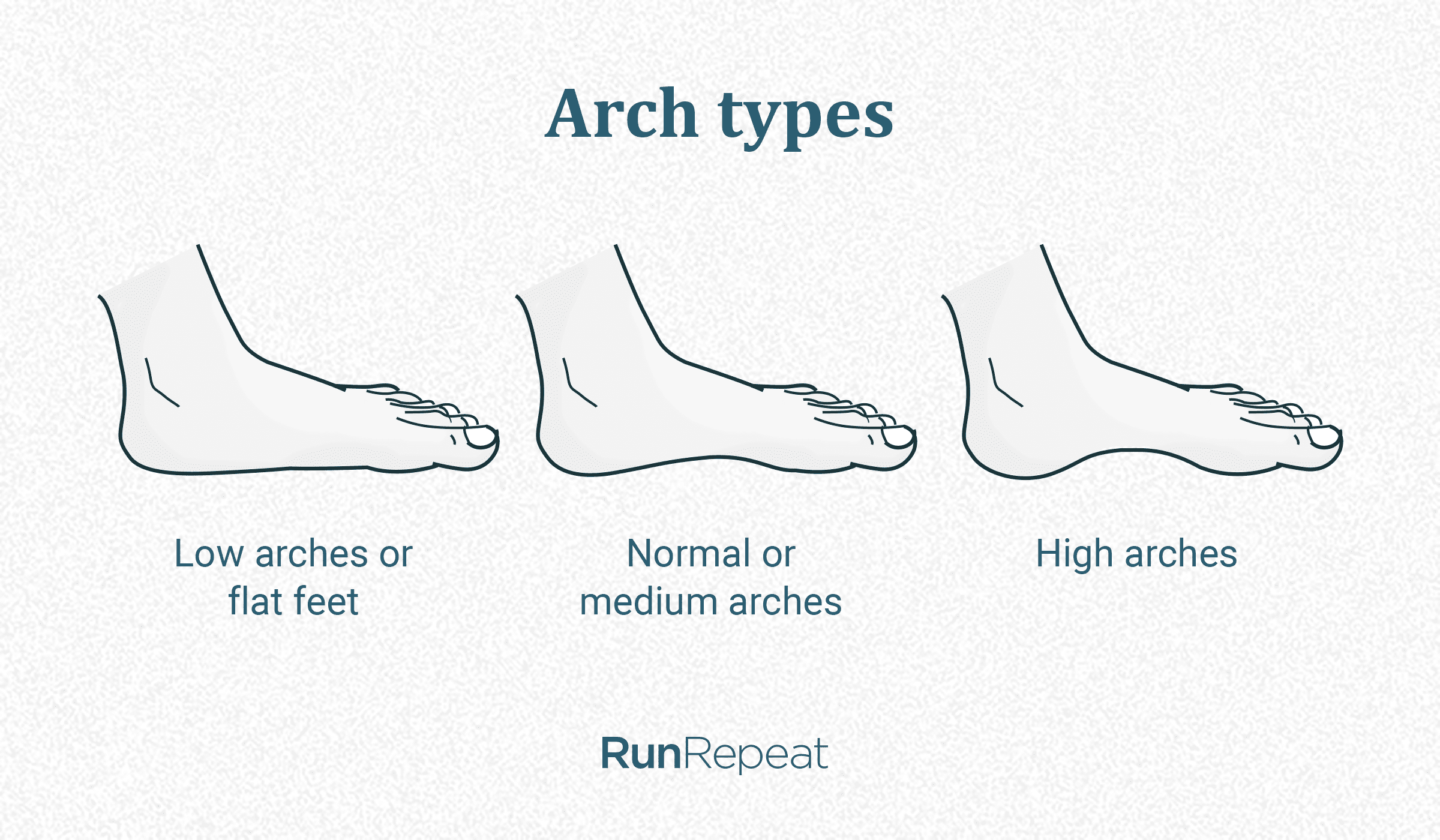
Because of this condition, flat feet enjoy more support.
Using very soft, very flexible, or barefoot/minimalist hiking boots can be very painful and even lead to injury for hikers with flat feet. However, minimalist footwear can be a part of a recovery plan, as using them VERY gradually can help with foot muscle strengthening.
5 features to look for in hiking boots for flat feet
Here, we recommend a stable platform. This stability is reflected in the softness of the midsoles, it can’t be too soft. It is also reflected in torsional rigidity because it prevents wobbling. And, given that it’s the heel that lands first and needs all the support it can get, we recommend stiff heel counters that lock the heel in place and prevent (to a certain degree) premature fatigue or excessive ankle rolling inwards.
- Torsional rigidity: look for boots that scored 3/5, 4/5, or 5/5 on our assessment.
- Heel counter stiffness: look for a 4/5 or 5/5 heel counter stiffness. This is accomplished by using stiff materials, whether in the internal or external heel counters.
- Not-too-soft midsoles: Based on our experience and lab tests, we recommend midsoles that scored at least 20 HA on our durometer.
- Wide platform. Hiking boots with wider platforms are more stable!
- Good grip, as always!
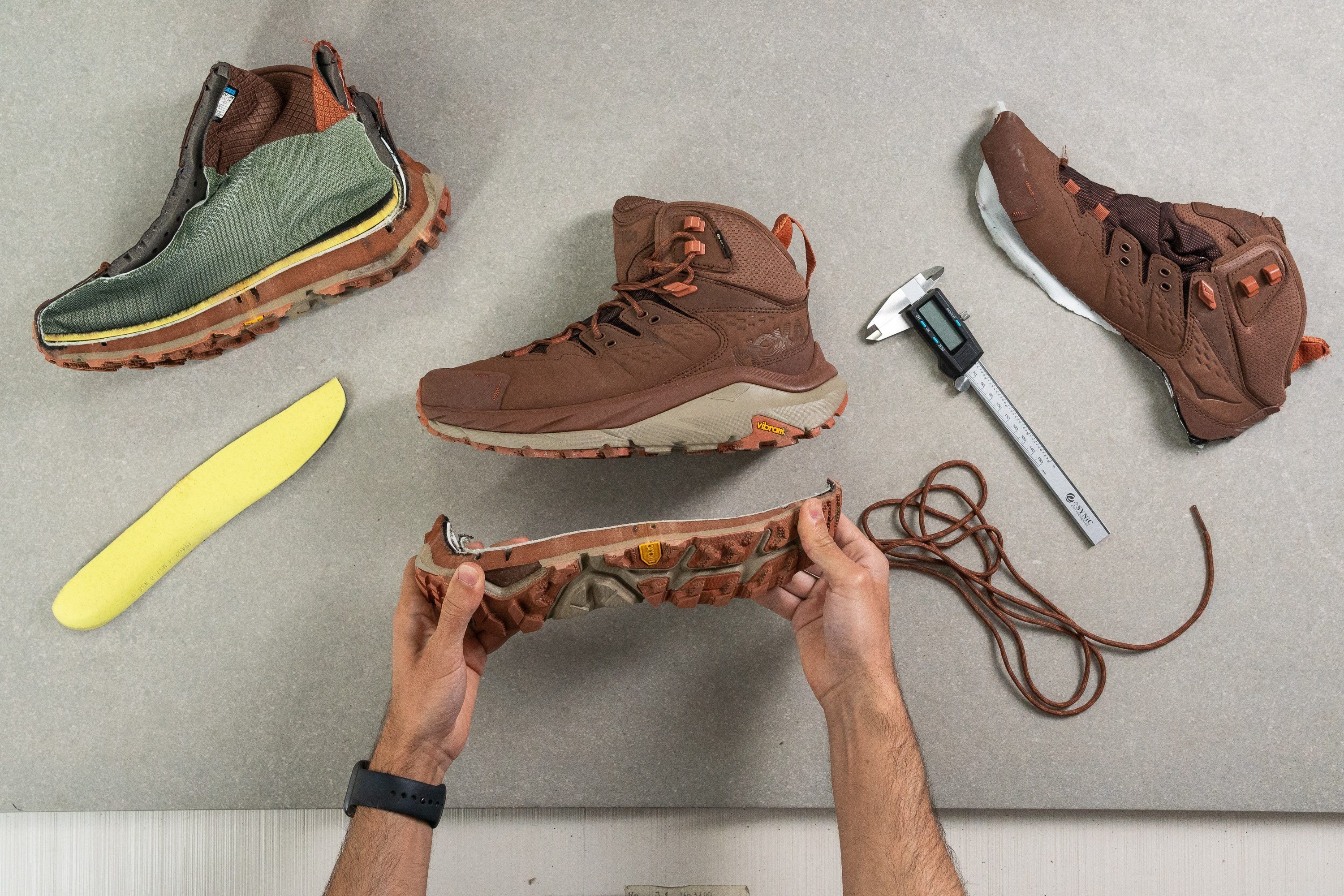
These boots should not be easy to twist!
As mentioned above, it’s best to look for a stiff platform. In our lab, we assess torsional rigidity and measure longitudinal stiffness.
It’s best to look for torsionally rigid hiking boots if you have flat feet. That means finding those that scored 3, 4, or 5 out of 5 on our assessment. Or, if you’re buying the boots in a specialised store, try twisting them and look for those that push back.
We prioritise torsional stiffness over longitudinal stiffness because hikers with flat feet overpronate, which happens “sideways”: the heel puts more pressure on the inner side of the boot. They don’t land in the middle of the heel and distribute the pressure evenly, but instead, they add more pressure on the inner side of the boot. This is where torsional rigidity can help.
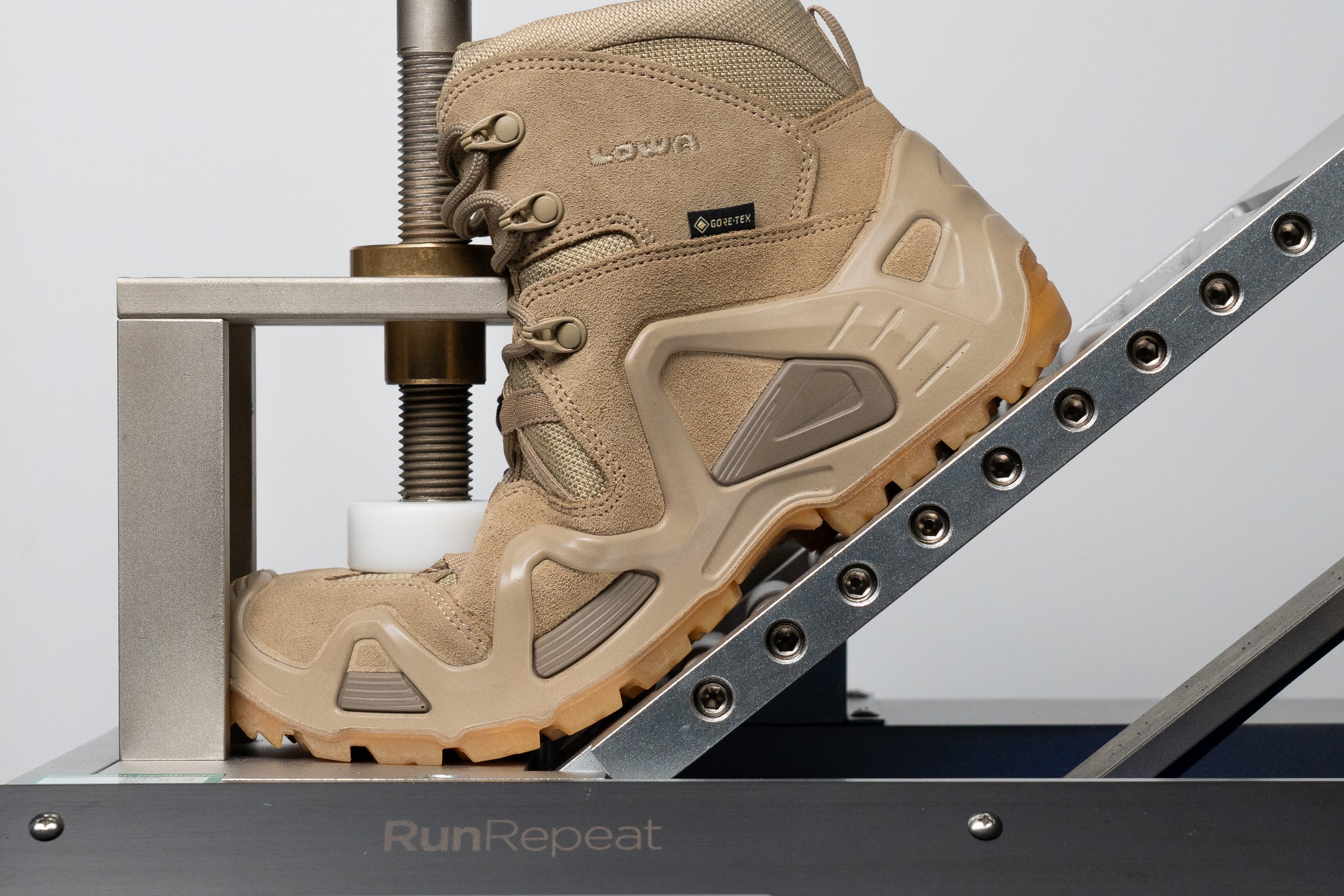
If, however, you want a stiffer boot overall, take into account the longitudinal stiffness as well. The higher the reading in Newtons, the stiffer the boot.
How to find stiff heel counters in hiking boots
Stiff heel counters are all the craze for hikers with flat feet! They allow for a perfect heel lockdown and, together with a firmer platform, help with overpronation. This stability eliminates unnecessary wobbling and micromovements that could cause pain or discomfort for hikers with flat feet.
The easiest way to assess the stiffness of the heel counter is to squeeze it and push it. Look for those that resist your pressure the most.
What makes heel counters stiff? Internal and/or external heel counters. External ones are easy to notice because, well, they are placed on the outside.
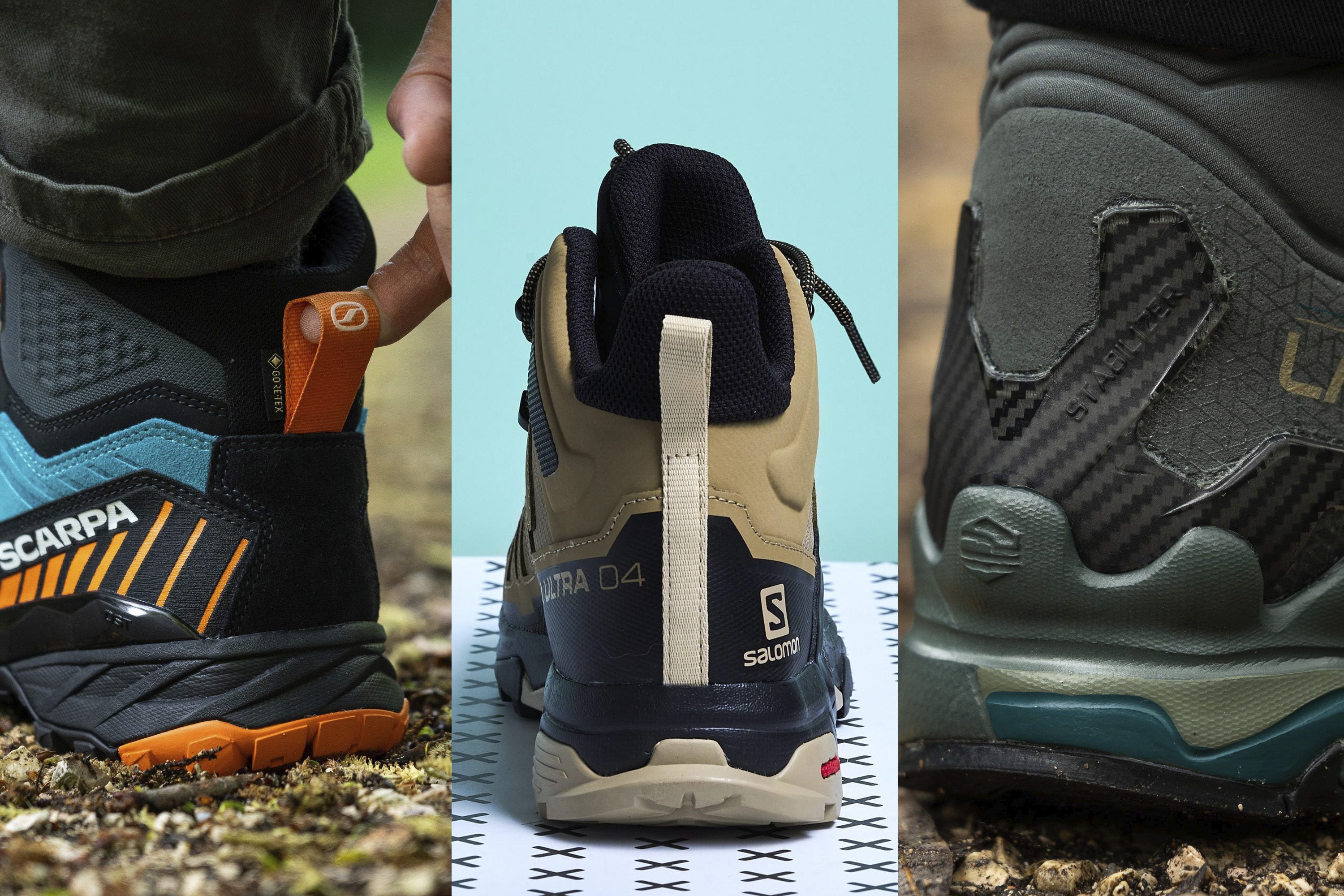
Internal ones can be noticed and assessed only after cutting the boot in half.
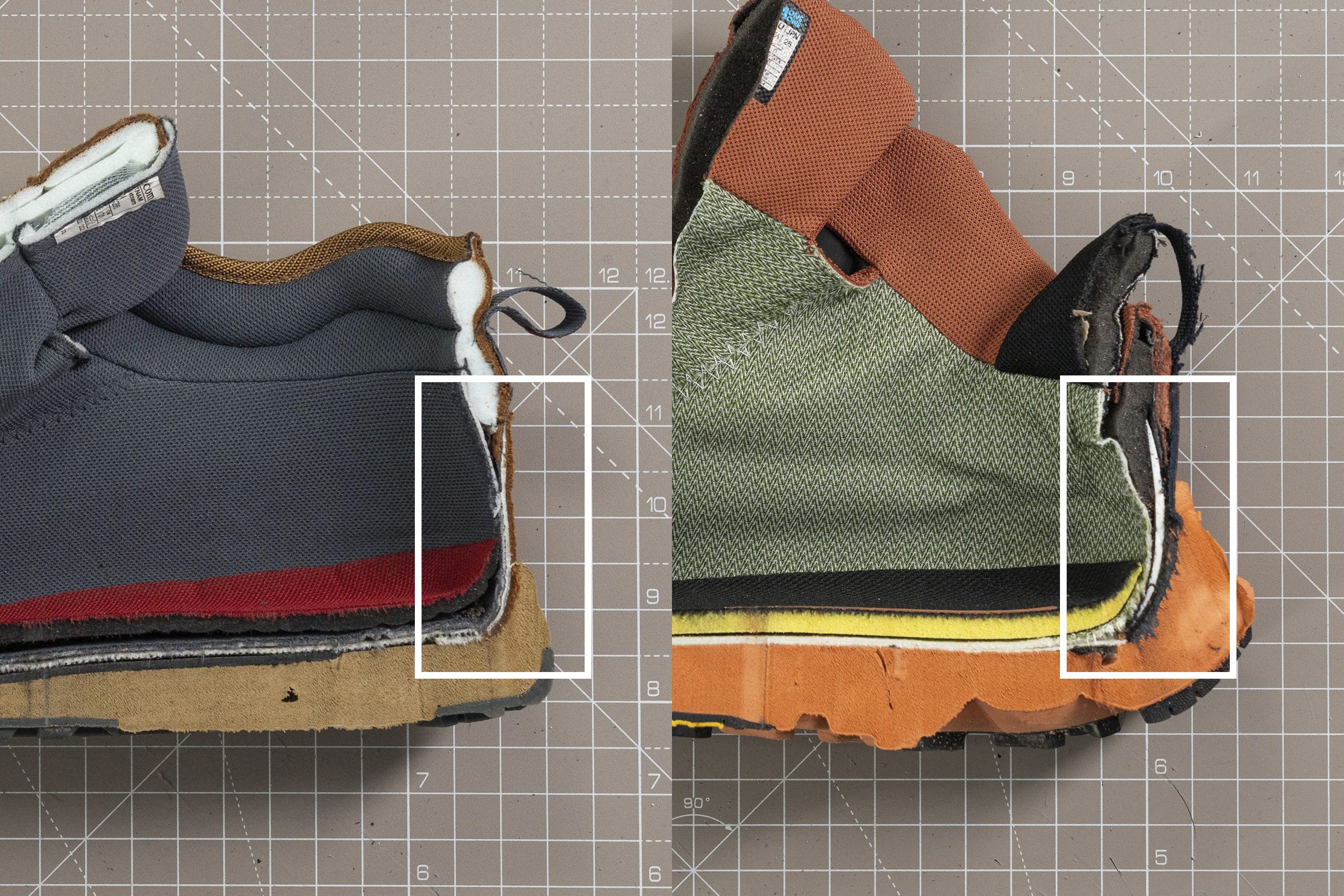
For flat-footed hikers, we recommend boots with heel counters that scored a minimum of 3 out of 5 on our test.
How to nail the cushioning in hiking boots for flat feet
Midsoles in hiking boots can be made of one or more materials with different softness levels and they can also have shanks embedded into them. The main purpose of the shanks is to make the platform stiffer and more protective.
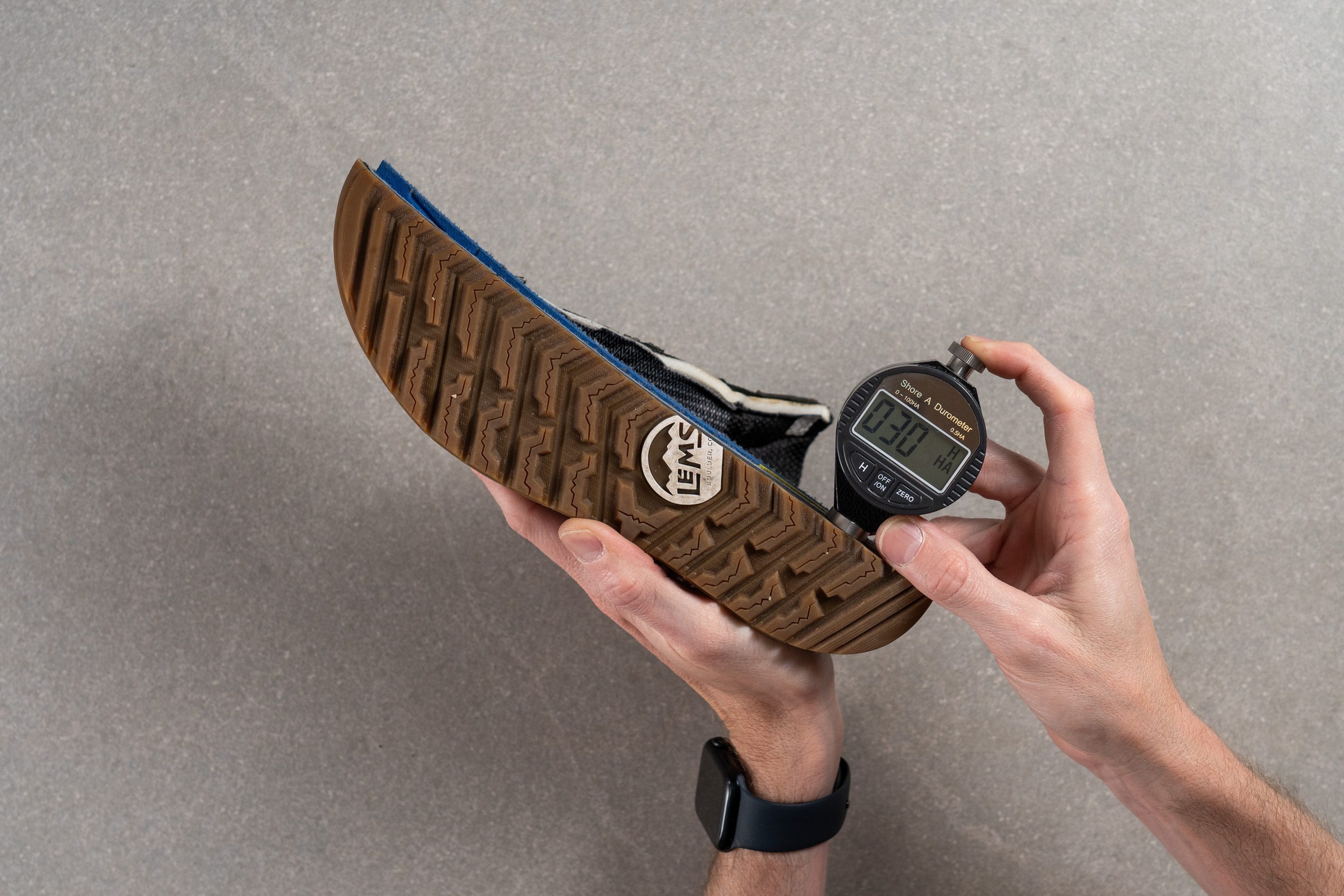
For flat feet, we recommend hiking in boots that scored at least 20 on the shore A durometer. Lower numbers indicate a softer midsole, while higher numbers describe a firmer midsole.
However, softness is only one piece of the puzzle. Shock absorption actually tells us how protective the midsole is towards our feet. The higher the shock absorption, the better the midsole at dampening the impact. This means that hiking boots with low shock absorption would make hikers' feet work more because they would have to deal with more impact forces that could have been "handled" by the midsole.
In hiking boots, a low shock absorption is anything below 85 SA.
It’s worth noting that we stick the durometer needle into the midsole when we’re measuring the softness. If you really need more softness, you can look for thicker insoles. Or, maybe you want to put your custom insoles in there and are curious how much room there is!
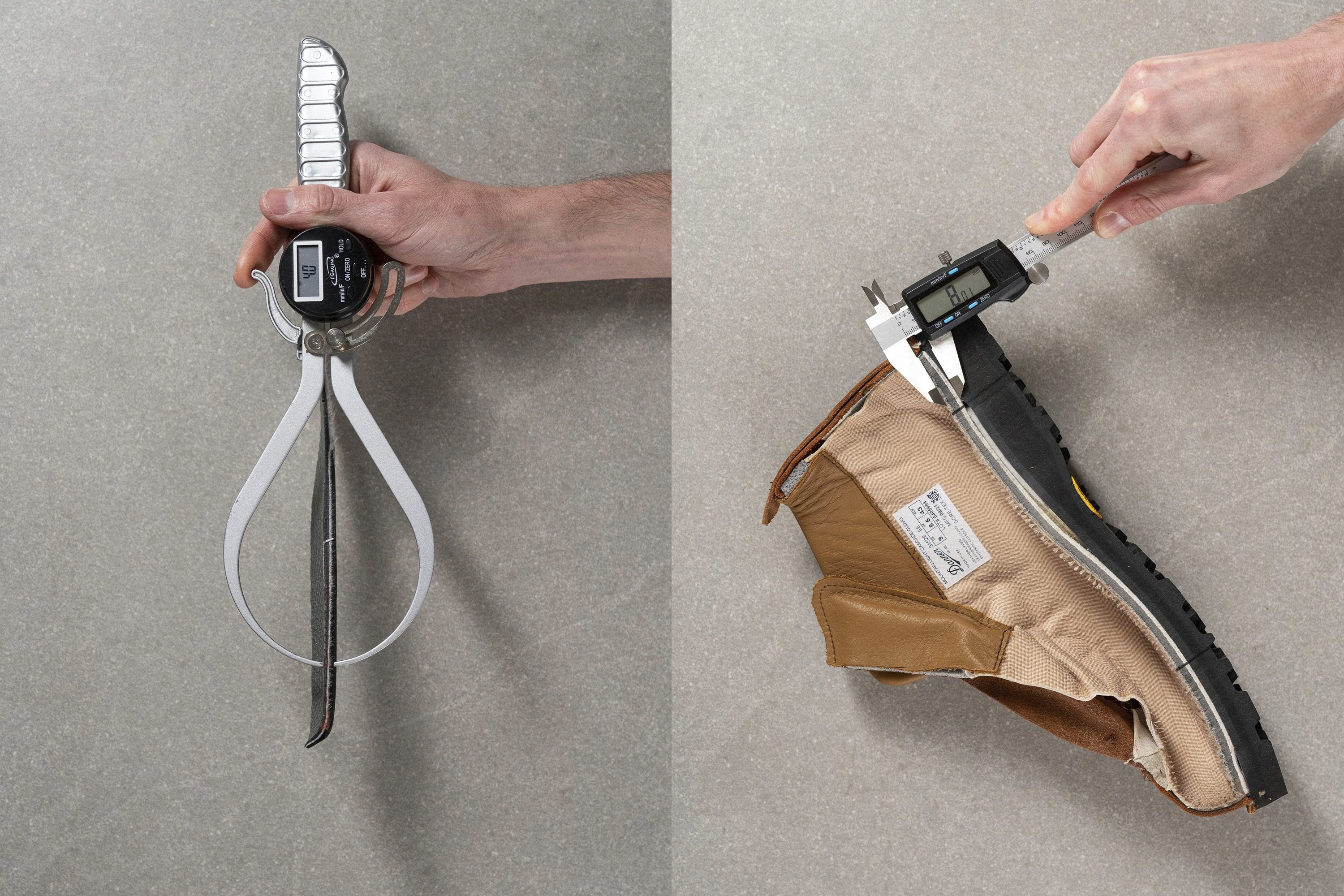
Extra stability for flat feet: wide platforms
Sure, there are hiking boots that are rigid and firm and placed on narrower platforms. That’s all still quite OK for flat feet, but in case you want that extra stability that comes from wider platforms, we’ve got you covered.
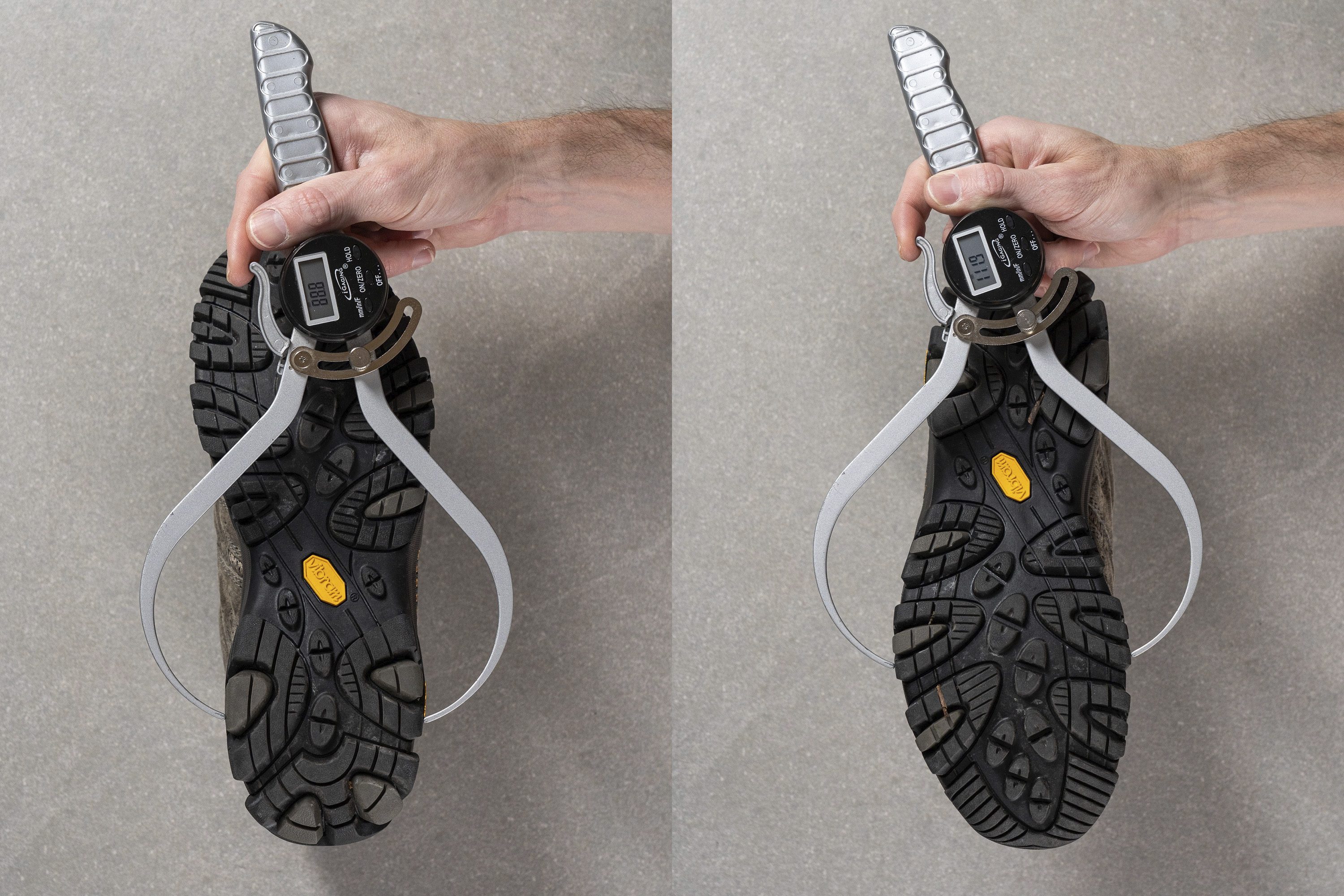
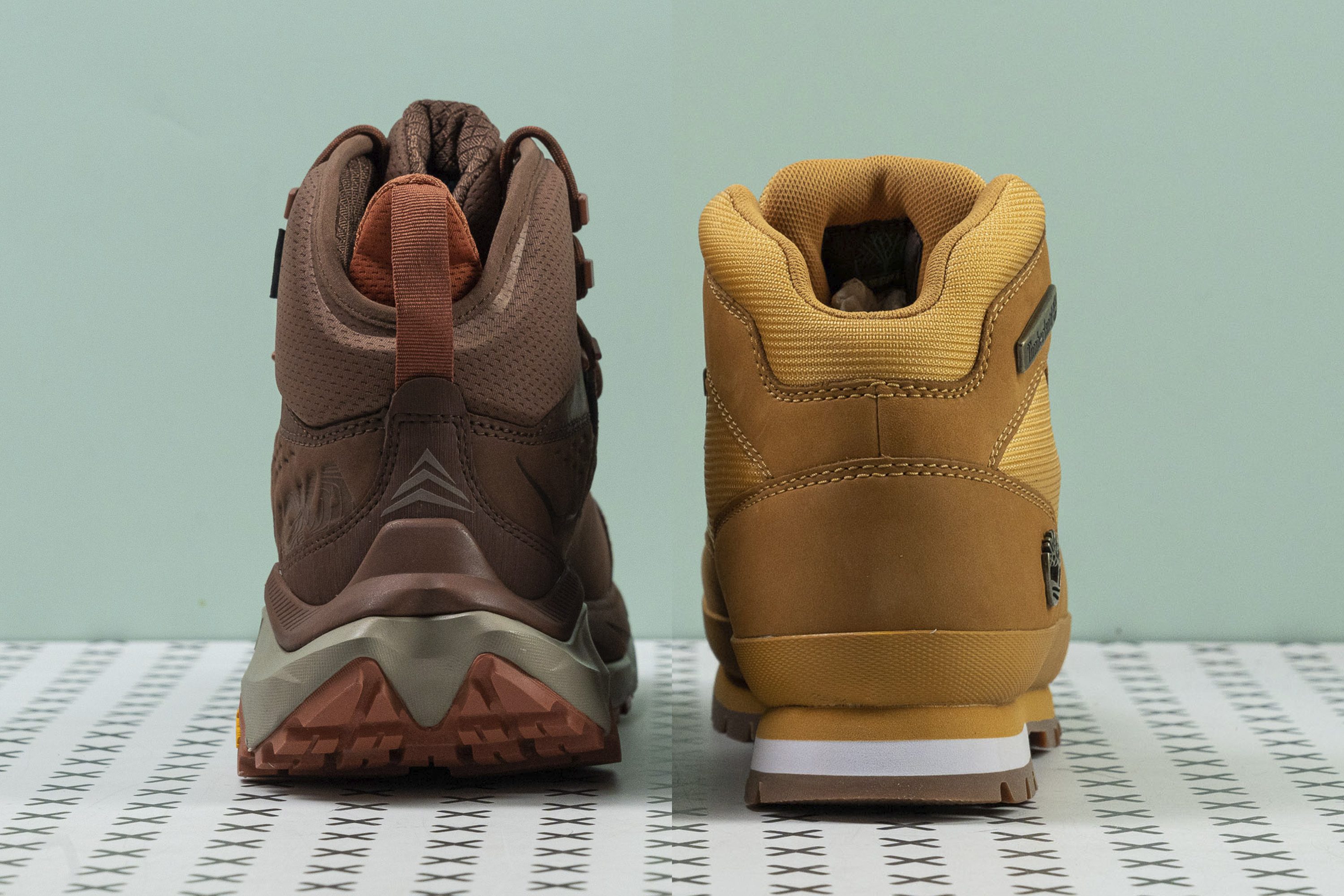
Best grip in hiking boots for flat feet
Regardless of the foot condition, finding a good grip that’s necessary for the terrain you’re covering, is a priority.
A general rule is: the deeper the lugs, the better the grip. However, deeper lugs are usually needed for mud, snow, slush, soft loose ground, etc. Shallower lugs are great for hard-packed surfaces or large flat rocks.
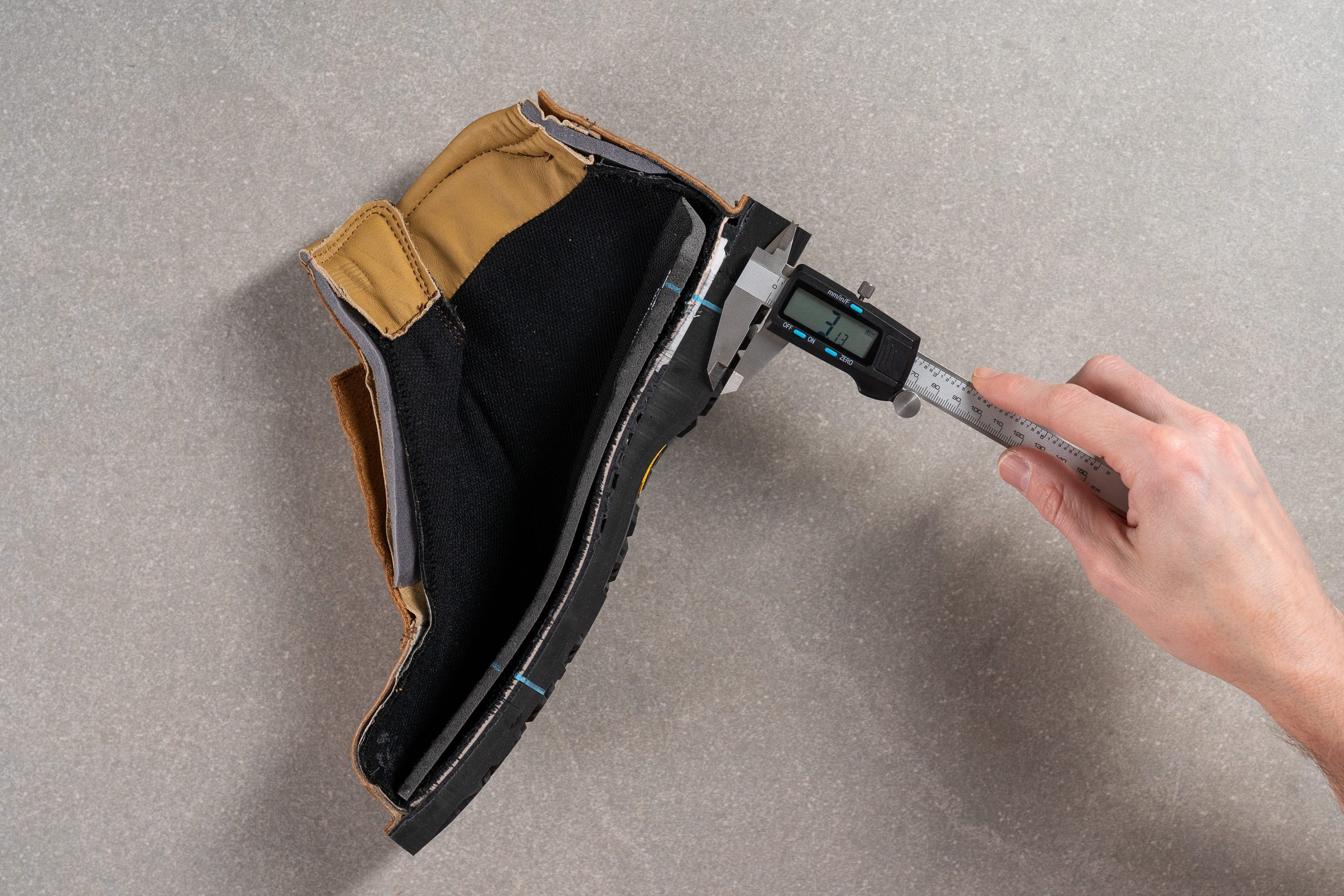
It’s not just the lug depth that plays a role in the grip, but the shape and number of the lugs and the distance between them.
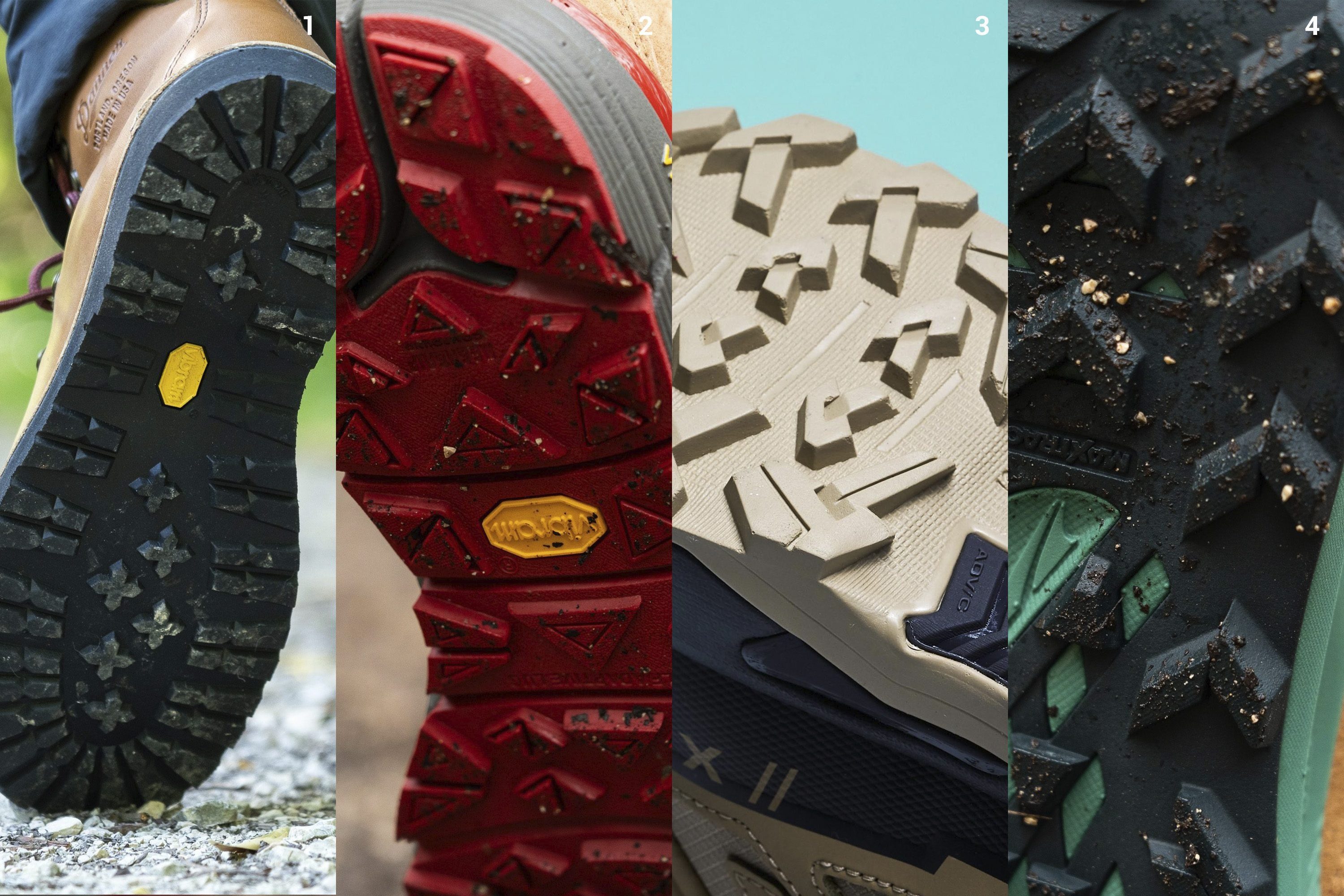
Outsole durability
We use a dremel and always apply the same force, RPMs, and time duration. This makes our durability test standardised and our test results objective and comparable.
Once the damage is done, we measure the depth of the dent with a tyre tread gauge. The deeper the dent, the less durable the outsole.

